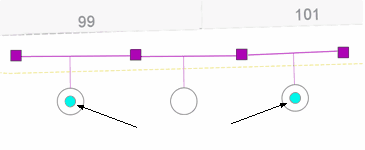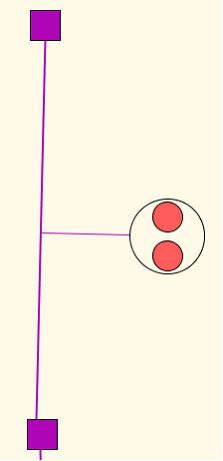In order to obtain a fully functional network product it is vital to adhere to the model rules when documenting your fiber or copper network. Any breach of the model rules of dpCom may cause problems when running various types of splitting and tracing functions. Should you document parts of your network in a manner that violates any of the stipulated rules you are given a warning dialog describing the nature of the breach. You may choose to override the warning, but keep in mind that this may affect the functionality of dpCom's splitting and tracing functions.
Model rules in dpCom
▪A route must be connected to node objects at both ends.
▪Objects (pipes, cables, ducts, multi-ducts, etc.) must form a coherent line without any breaks in any route. All routes that the object is connected to must also form a coherent line between two or more node objects.
▪An object (pipe, cable, duct, multi-duct etc.) may only exist once directly in a pipe.
▪A pipe object must be split in order to be able to put a joint on the loop. The pipe should be split before the loop is on the wire.
▪A cable should be in a route contents (pipe, sub-pipe or directly in the route), otherwise the cable can not be connected to the node contents (rack, distribution point/ODF). The route must be connected to the node object.
Ways of documenting the network which should be avoided
There are some ways to document fiber-optic and copper network (see an example below), that should be avoided. If you try to document your network this way, you will get a warning. If the network documentation does not comply with the dpCom model rules various functions such as splitting functions, searches and trace functions will not work satisfactorily.
A route must be connected
It is required that all routes are connected to a node object at both ends. Only complete connections at route level will ensure full topology in the network which is required to make fiber and copper objects traceable and searchable. These connections create a whole network and allow to execute search and trace functions. This requirement must also be met when you split a route, with or without content.

Objects must form a coherent route
An object (pipe, cable, duct, multi-duct etc.) must form a coherent line without any breaks in any route. All routes that the object is connected to must also form a coherent line between two or more node objects. This is important, for example, for correct execution of the split functions.
An example of documentation below shows a violation of dpCom model rules.

An object may exist in a pipe only once
An object may only exist once in a route in order to execute functions in dpCom, such as connect and split correctly. The system can not recognize in which node cable turns as non-split cable and in which node there are two loose ends of the same cable. This can cause problems at the connecting of fiber in the nodes, the spliting of cable, because it is difficult to find the cable end point. If you nevertheless wish to have the same object all the way to a node and then back the same way, you must add the object in two different parent objects, for example, that cable is in the different pipes or sub-pipes/duct. The example below shows a violation of dpCom model rules.

The same cable object in a pipe 2 times